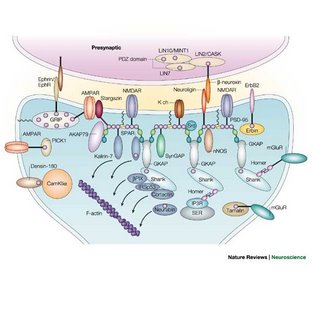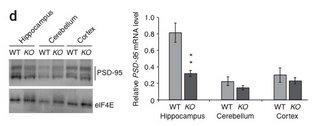Fragile X mental retardation is a very common mental disability resulting from reduced expression of a protein called fragile X mental retardation protein (
FMRP). The most obvious difference in Fragile X brains is that the receiving end of most excitatory synaptic input, dendritic spines, are misshapen. They look thin and immature rather than mushroom-y or stubby. FMRP has been shown in recent times to regulate the expression of other proteins at the translational level. It can bind different mRNAs and interfere with their ability to be translated into proteins.
PSD-95 (Post-Synaptic Density-95) is a
central organizing protein in the architecture of synapses. It contains several protein-protein interaction domains, allowing it to serve as a scaffold in dendritic spines. Of particular interest is its ability to regulate a dendritic spine's excitability by clustering glutamate receptors in the post-synaptic density. Check the figure below. It can hook up the major excitatory neurotransmitter receptors to the NMDA receptor (heavily implicated in learning), and it can hook these both up to the actin cytoskeleton which determines the whole shape of the spine/synapse.

There is a
new paper in Nature Neuroscience showing that FMRP binds to PSD-95 mRNA and that binding increases the stability of PSD-95 mRNA. The first reason this is novel is because normally FMRP regulates RNAs by keeping them away from the protein synthesis machinery, but in this case it is keeping the RNA away form degradation. Another novel aspect is that FMRP appears to bind in between to AU-rich elements (AREs) in the PSD-95 mRNA, connecting it to a larger literature regarding AREs and mRNA degradation. This paper does not show experiments showing that these AREs target PSD-95 mRNA for decay, but it leaves open the possibility. The idea would be then that FMRP binds the mRNA and blocks binding of proteins that would like to grab the RNA and drag it off to be degraded.
I have only read the paper once, but here is a figure that is bothering me:

They are showing that PSD-95 protein levels are reduced in FMRP knockout mice, ostensibly because FMRP is no longer stabilizing the mRNA so we get less protein. It appears from looking at the graph and the western blot that they are using eIF4E as a loading control (i.e. they are normalizing the PSD-95 protein levels to the eIF4E levels), but as far as I know this is very unconventional. Conventionally, something like tubulin or actin would be used as a loading control. I'm sure some reviewer wiser than me got a reasonable explanation, but I'd be willing to believe that eIF4E levels could be affected by loss of FMRP. Look at the cerebellum data. It looks weird, right?
Labels: Fragile X, PSD-95